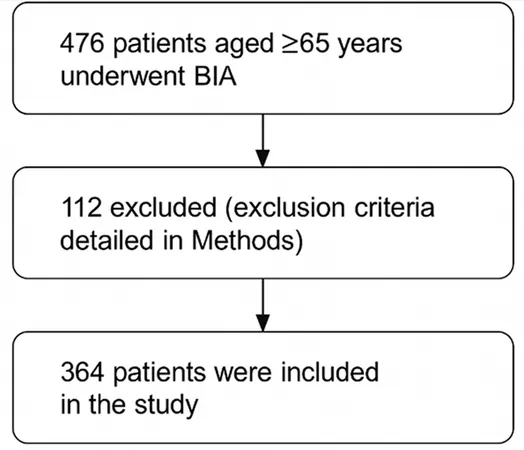
Why Sarcopenic Obesity is a Greater Threat to Older Adults' Health Than You Think
2025-07-02
Author: Arjun
Understanding Sarcopenic Obesity: A Dual Health Threat
Sarcopenic obesity (SO)—a dangerous blend of age-related muscle loss (sarcopenia) and increased body fat—poses severe health risks for older adults. While sarcopenia and obesity are usually studied separately, their combination creates a formidable health challenge that often goes unnoticed.
The Hidden Risks: Frailty, Falls, and Hospitalization
Older adults with SO may seem well-nourished, yet they face increased frailty, a higher risk of falls, reduced functional ability, and greater likelihood of hospitalization. Numerous studies indicate that the consequences of SO can be far worse than those of sarcopenia or obesity alone, making it critical to reevaluate how we perceive these conditions in geriatric healthcare.
New Definition, New Insights
In an effort to standardize the diagnosis of SO, the European Society for Clinical Nutrition and Metabolism (ESPEN) and the European Association for the Study of Obesity (EASO) introduced a consensus definition in 2022. This new classification integrates factors like muscle quality into the understanding of SO, allowing for more accurate research and better clinical comparisons.
Targeting Prevention: The Need for Tailored Interventions
Given the complex nature of SO, it requires personalized strategies that focus on preserving muscle while managing body fat. Effective interventions may include functional foods and well-structured physical activity plans, which hold promise as society grapples with an aging population and rising cases of SO.
Unraveling the Causes of Sarcopenic Obesity
The origins of SO are multifaceted—spanning lifestyle habits, genetics, and various environmental factors. Some contributing elements include lack of exercise, chronic illnesses, nutritional deficiencies, and hormonal changes, all exacerbated by the aging process.
SO's Impact on Daily Life and Mortality
Research illustrates that SO hinders daily activities and contributes to increased frailty, leading to potential mortality issues in older adults. The imbalance of loss of muscle functionality and excess fat means SO could be an independent risk factor for adverse health outcomes, surpassing the effects of either condition alone.
The Role of Comorbidities
Certain risk factors—like older age, gender, hypertension, and diabetes—are significantly linked to the development of SO. This highlights the urgency of targeted interventions tailored to those at high risk.
New Perspectives on Screening and Management
To combat SO, a holistic approach to screening is essential. Tools like the Mini Nutritional Assessment (MNA-SF) and handgrip strength tests can be integrated into routine health checks. Upon identifying SO, a comprehensive, individualized care plan—including resistance training and dietary optimization—should be established to enhance patient outcomes.
Future Research: A Call to Action
This burgeoning field calls for prospective studies to solidify our understanding of SO’s implications. Randomized trials are necessary to evaluate the effectiveness of nutrition and exercise interventions, while deeper research into the underlying biological processes related to SO could pave the way for innovative solutions.
Conclusion: Addressing Sarcopenic Obesity for a Healthier Tomorrow
As SO emerges as a critical concern in geriatric health, the healthcare community must adapt. Emphasizing the importance of integrated geriatric assessments and proactive management strategies will be crucial in mitigating the adverse effects of this complex condition. By acknowledging the unique challenges posed by SO, we can pave the way for healthier, more independent lives for older adults.



 Brasil (PT)
Brasil (PT)
 Canada (EN)
Canada (EN)
 Chile (ES)
Chile (ES)
 Česko (CS)
Česko (CS)
 대한민국 (KO)
대한민국 (KO)
 España (ES)
España (ES)
 France (FR)
France (FR)
 Hong Kong (EN)
Hong Kong (EN)
 Italia (IT)
Italia (IT)
 日本 (JA)
日本 (JA)
 Magyarország (HU)
Magyarország (HU)
 Norge (NO)
Norge (NO)
 Polska (PL)
Polska (PL)
 Schweiz (DE)
Schweiz (DE)
 Singapore (EN)
Singapore (EN)
 Sverige (SV)
Sverige (SV)
 Suomi (FI)
Suomi (FI)
 Türkiye (TR)
Türkiye (TR)
 الإمارات العربية المتحدة (AR)
الإمارات العربية المتحدة (AR)